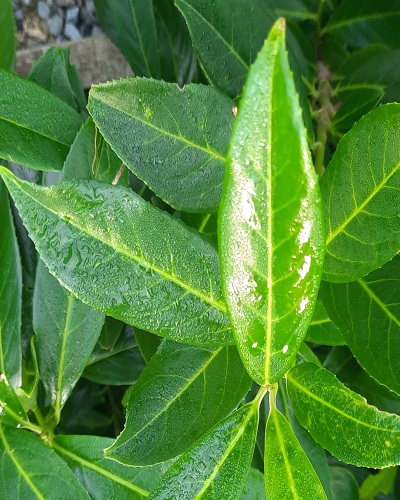
Cherry Laurel Hedging
CHERRY LAUREL HEDGING
Cherry Laurel Hedging – Prunus laurocerasus is a fast growing evergreen hedge. Laurel can take regular trimming. Cherry Laurel prefers good free draining soil. This is the most common Laurel used for hedging. It has large shiny leaves and candles of small flowers in April (if not pruned). Left unpruned this Cherry Laurel Hedging will reach 8m. It will grow well in any reasonable soil but the site should be well drained.
There are a few different varieties of Cherry Laurel Hedges which we grow and sell here in Hylands Nursery.
Prunus Novita has a long narrow dark green leaf.
Prunus laurocerasus Rotundifolia has a rounder wider leaf and is bushy in habit.
Prunus Genolia, similar to Novita Laurel with its long narrow dark green leaf, but will grow in a neat column shape.


HYLAND’S PRICE LIST – PLANTS FOR CHERRY LAUREL HEDGING
Prices listed above are for collection from Hyland’s Nursery in Oulart. For more information please visit our terms & conditions page.
Ways to Buy Cherry Laurel Hedging at Hylands Nursery
There are three different ways you can buy laurel
Pots or containers:
Laurel in pots can be planted all year round and can be any size, from a plant in a 9cm pot to a plant in a 100litre tub. Their root is settled into the pot and the plant has been actively growing in the pot thus it is well established. A plant in a pot can be sown all year round. As it is established in the pot, there is little disturbance to the plant when planted into the ground so it is more likely to grow. It is seldom that a plant in a pot fails unless the watering conditions haven’t been correct. It will need to be watered in well when initially planted. If planted during a hot time or in the summer, it may need to be watered a few times a week until they get established in the ground.
Root balled:
Root balled plants are larger plants that come in a root wrap of hessian. You leave this hessian on when planting. You only plant these plants when the plant is dormant or has stopped growing for the winter. They are planted from October/November to April/May depending on what the season is like i.e. if the spring is early or not, or if the autumn is very dry.
Bare rooted:
There are plants that have no soil on their roots. They are usually small, single stemmed plants. It is important when you get these plants that you keep the roots moist and don’t let the roots dry out. You should keep them in the bag or heal the roots into sand or soil until you are ready to plant them. You should try to have the ground ready before you get them, and plant them as soon as you get them so they have a good chance of success. They should be planted between November and March but the earlier in the winter the better as it gives the roots a chance to settle in before the growth starts.
Cherry Laurel Hedging – Planting tips
Distance apart:
Smaller plants should be planted at a distance of 50cm apart in a single row. Larger plants won’t need to be planted as close, but how close will depend on how soon you want your hedge to look full.
Preparation before planting
The ground should be clean and free from weeds and grass. This gives the new plants a good chance to get established. If the area you are going to plant them in has grass or weeds, the ground should be sprayed off a week or so before planting to avoid any competition. To help prevent too many weeds appearing after you have planted your cherry laurel hedging, I find it a good idea to put your grass clippings or mulch around the plants as this smothers out the weeds and helps prevent the plants drying out.
Depth
The plants should be planted deep enough to cover the roots. They do not like to be planted too deep as this may kill them or stunt their growth.
Cherry Laurel Hedging doesn’t like to be lying in water so if the area you want to plant them in is wet, you may need to consider draining the ground or making a mound/ditch of top soil on top of the ground and plant them into this.
Laurel can grow well in full sun and in shade.
Aftercare
Once the Cherry Laurel Hedging is established you can trim it 1 to 2 times a year. Spring/early summer is a good time to give its’ first trim, it can be cut back hard at this time of the year, if you like, as it has the full summer to recover. Cherry Laurel for hedging shouldn’t be trimmed if the weather is really hot and dry. A light trim in late July/August keeps it in shape for the winter and still gives it time to recover in time for winter. You can give your laurel hedge a feed of any high nitrogen feed (eg. in the nursery we use 18-6-12) or poultry manure pellets in late spring/early summer.
General Problems with Cherry Laurel Hedges
Yellow leaves:
When the leaves turn yellow and fall off this may be caused by lack of water or too much water.
Lack of water (drought):
If you have a newly planted laurel hedge that is turning yellow and is losing its leaves, it is generally not getting enough water. It should not be let get too dry in the first year. If planted in a dry time you will need to water it in well and water it a few times a week- weather dependant.
Too much water (waterlogged):
If you have a more established laurel hedging and it starts turning yellow, the ground may be waterlogged. Laurel hedging doesn’t like sitting in water for a long period of time.
Stress:
If you have planted large root balled hedging, if your water conditions are correct, it may be the plant reacting to its change of environment and is under a little stress, but once it gets going it should be ok.
Hunger:
Another reason for your leaves turning yellow is hunger and your hedge may need a granule or liquid feed with high nitrogen or some poultry manure pellets.
Shot hole
Laurel hedging at times suffers with shot hole, where the leaves have holes in them. This usually affects plants under pressure, but generally grows out with time, without any treatment but feeding and watering can help the plant to recover faster.
Is Laurel poisonous?
Laurel hedging is poisonous if the leaves and flowers are eaten by humans or animals. It is classed as a potentially harmful plant but is one if the least harmful plants and has no reported cases of serious problems with it.
If you have any questions about Cherry Laurel Hedging, reach out to us by phone +353 87 277 3492 or email for answers.









